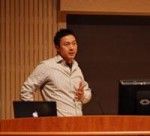Capturing Courage on Film

On Tuesday, March 2, at 7:00 p.m., photographer Jeff Sheng gave a presentation called “Fearless,” a photo series that documents gay/lesbian high school and college athletes. Sheng began by describing the experience of growing up in an upper-middle class suburb outside of Los Angeles, which he called “kind of like the OC.” The environment was less than welcoming to homosexuality. Sheng recalls his experiences there as providing a foundation for the work he did later on in “Fearless.”
“In a lot of ways, this project really started in high school,” Sheng said. “When I was a freshman on the tennis team, there was this senior that came out to the rest of the team. I was completely closeted at that point and kind of homophobic. While I definitely wasn’t the main offender in the situation, I did join in with everyone else on the team in harassing him. He eventually quit the team and, to a certain degree, having to take responsibility for that has haunted me ever since.”
While high school may have influenced his most famous work, it was only when Sheng became an undergraduate at Harvard University that he began actively pursuing photography as both an art form and a method of promoting social justice.
“I was originally interested in going to law school, and becoming some kind of civil rights attorney,” Sheng said. “When I got to Harvard, though, and realized how many people were getting involved with law as a sort of ‘guaranteed track to success,’ I became sort of disillusioned with the whole thing.”
At around the same point in time, Sheng practically accidentally discovered the school’s photography department.
“I was failing this poetry class and decided to just get out of it,” Sheng said. “I had taken a photography class at a community college the summer after my senior year of high school and had really enjoyed it, so I decided to give it a shot at Harvard. When I got involved with the department, I began to realize how much the professors really valued social justice and were promoting the use of photography as a means of furthering these causes.”
Sheng quickly immersed himself in the department and began using photography as a method of capturing his life and expressing his new identity as an openly gay man.
“I had actually mentioned the idea behind ‘Fearless’ when discussing the topic of my undergraduate thesis,” Sheng said. “My advisors really liked it, but they told me that I should hold off on the project until later on.”
Sheng listened to their advice and received an e-mail from one of the professors a year after graduating, asking him about where he stood on the project.
“It turned out that my advisor’s stepson had seen some of my photographs and had been inspired by them to come out of the closet. It was a big moment for the family and I think that after it happened, my professor was very eager for me to continue my work,” Sheng said.
Sheng was offered a job as a teaching assistant (TA) at Harvard, in exchange for room and board, and access to all of Harvard’s photography facilities. From there, he began working on “Fearless” by e-mailing his former college roommates, a few of whom had been on sports teams, and asking if they knew any openly gay college or high school athletes. Using their responses as a starting point, he began to establish contacts with a number of athletes around the country, all of whom were eager to be photographed as a part of “Fearless.”
“At first, I was having a hard time figuring out how to photograph the subjects,” Sheng said. “I remember photographing the first person in the series over and over again and not being happy with any of the results. Finally, I decided to have him work out, photographing him in between running lines.”
What Sheng got out of his subject was the look of defiance and fearlessness that he would later aim to capture with the other subjects.
Sheng has since taken the project to numerous colleges and universities around the country, including Oberlin, Brown and UPenn. Colgate is the latest stop on the tour, and the exhibition is on display until March 8 in the Clark Room.



